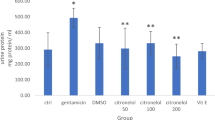Abstract
Recent studies have shown that paraoxanase (PON1) has protective effect against oxidative stress and hence can act as an antioxidant. A time course study was carried out in order to find out alterations in PON1 activity in cyclophosphamide (CYP) induced renal injury. Eight to ten weeks old female rats were administered CYP at the dose of 150 mg/kg body wt. (i.p.) and sacrificed at 6, 16, or 24 h after treatment. Saline treated rats served as control. CYP exposure for 6 h caused a dramatic increase in PON1 activity (83%), which escalated to 160% at 16 h. The renal PON1 activity reached control values 24 h after treatment with CYP. The renal malondialdehyde level was unaltered 6 h after treatment with CYP and an increase by 35% was observed 16 h after treatment with CYP. The present investigation shows for the first time that an increase in renal PON1 activity is an early biochemical event in cyclophosphamide induced renal damage. It is suggested that this enzyme may have a role within the antioxidant systems of the kidney.
Similar content being viewed by others
References
Costa LG, Richter RJ, Li WF, Cole T, Guizzetti M, Furlong CE (2003) Paraoxonase (PON 1) as a biomarker of susceptibility for organophosphate toxicity. Biomarkers 8:1–12 Review
Costa LG, Cole TB, Furlong CE (2005) Paraoxonase (PON1): from toxicology to cardiovascular medicine. Acta Biomed 76(Suppl 2):50–57
Dollery C (1999) Cyclophosphamide. In: Dollery C (ed) Therapeutic drugs. Churchill Livingstone, Edinburgh, pp 349–353
Ellman GL (1959) Tissue sulphydryl groups. Arch Biochem Biophys 82:70–77
Gur M, Aslan M, Yildiz A, Demirbag R, Yilmaz R, Selek S, Erel O, Ozdogru I (2006) Paraoxonase and aryl esterase activities in coronary artery disease. Eur J Clin Invest 36:779–787
Manda K, Bhatia AL (2003) Prophylatic action of melatonin against cyclophosphamide induced oxidative stress in mice. Cell Biol Toxicol 19:367–372
Ohkawa H, Oshini N, Yagi K (1979) Assay for lipid peroxides in animal tissues by thiobarbituric reaction. Anal Biochem 95:351–358
Takahashi Y, Aoyama F, Ito F, YamamuraY (1967) Evaluation of phenyl acetate esterase activity as an index of liver damage. Clin Chim Acta 18:21–32
Tsuzura S, Ikeda Y, Suehiro T, Ota K, Osaki F, Arii K, Kumon Y, Hashimoto K (2004) Correlation of plasma oxidized low-density lipoprotein levels to vascular complications and human serum paraoxonase in patients with type 2 diabetes. Metabolism 53:297–302
Vasdev S, Gill V, Singal PK (2006) Beneficial effect of low ethanol intake on the cardiovascular system: possible biochemical mechanisms. Vasc Health Risk Manag 2:263–276
Acknowledgments
We thank CMC research committee for the financial support for the study and Dr Indirani, Associate professor in Anatomy for her guidance in histological studies
Author information
Authors and Affiliations
Corresponding author
Rights and permissions
About this article
Cite this article
Abraham, P., Sugumar, E. Enhanced PON1 activity in the kidneys of cyclophosphamide treated rats may play a protective role as an antioxidant against cyclophosphamide induced oxidative stress. Arch Toxicol 82, 237–238 (2008). https://doi.org/10.1007/s00204-007-0240-3
Received:
Accepted:
Published:
Issue Date:
DOI: https://doi.org/10.1007/s00204-007-0240-3




